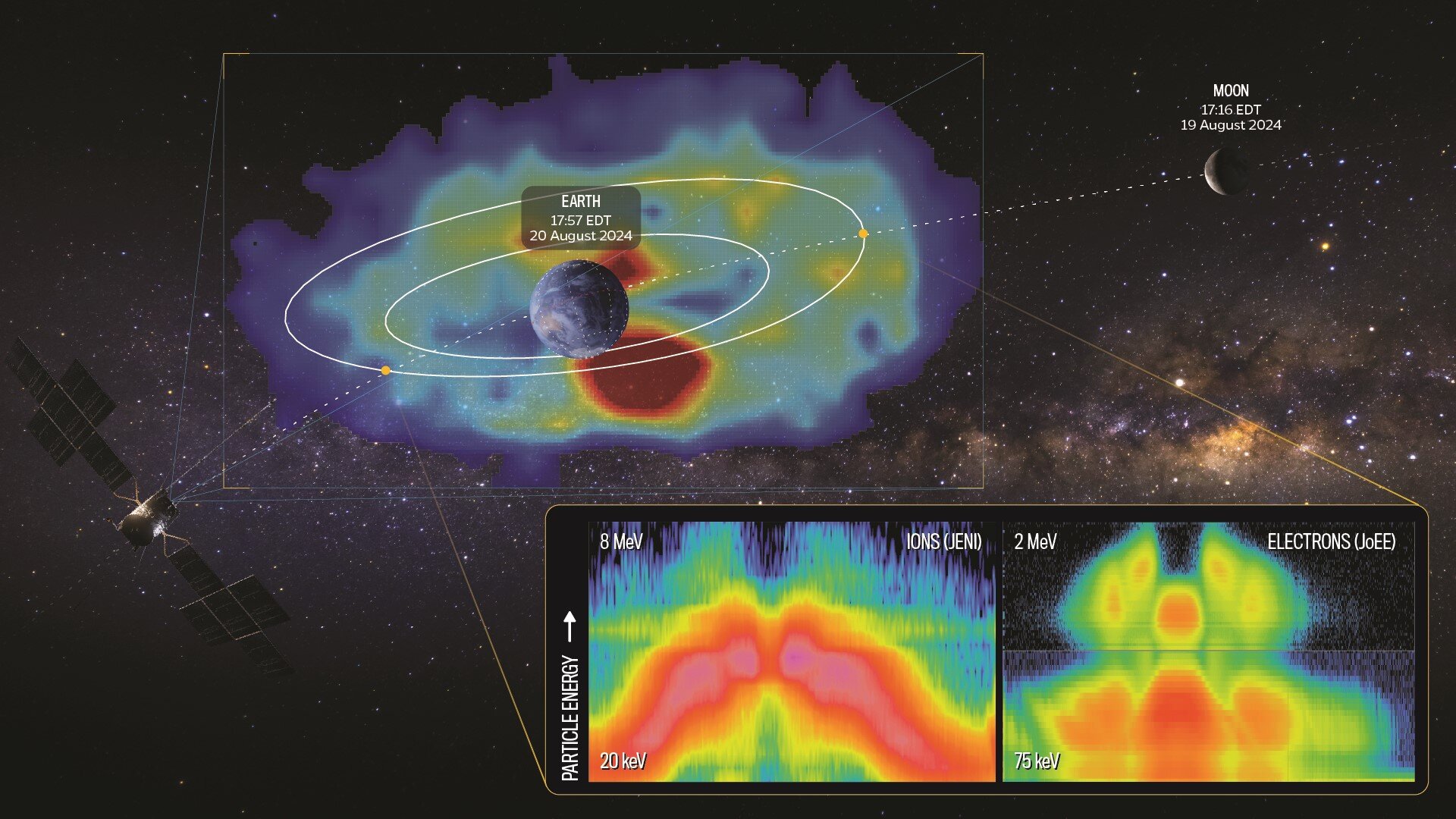JUICE/PEP Captures Sharpest Image of Earth’s Radiation Belt
From August 19-20, ESA’s (European Space Agency’s) Juice (Jupiter Icy Moons Explorer) mission made history with a daring lunar-Earth flyby and double gravity assist maneuver, a spaceflight first. As the spacecraft zipped past our Moon and home planet, Juice’s instruments came online for a dry run of what they’ll do when they reach Jupiter. During that time, two of NASA’s onboard instruments added another first to the list: capturing the sharpest-ever image of Earth’s radiation belts – swaths of charged particles trapped in Earth’s magnetic shield, or magnetosphere.
The Jovian Energetic Neutrals and Ions (JENI) instrument, built and managed by the Johns Hopkins Applied Physics Laboratory (APL) in Laurel, Maryland, on behalf of NASA – to which IRAP has characterized and delivered the MicroChannel Plate detectors – and part of the PEP (Particle Environment Package) instrument suite led by the Institute of Space Physics (IRF) in Kiruna, Sweden, took the image as Juice soared away from Earth. What it captured is invisible to the human eye. Unlike traditional cameras that rely on light, JENI uses special sensors to capture energetic neutral atoms emitted by charged particles interacting with the extended atmospheric hydrogen gas surrounding Earth. The JENI instrument is the newest generation of this type of camera, building on the success of a similar instrument on NASA’s Cassini mission that revealed the magnetospheres of Saturn and Jupiter.

An illustration showing the trajectory of ESA’s Juice spacecraft during its lunar-Earth gravity assist, featuring a high-resolution ENA image of the million-degree hot plasma halo encircling Earth captured by NASA’s JENI instrument. The white rings denote equatorial distance of 4 and 6 Earth radii. The inset showcases measurements taken by the NASA’s JENI and JoEE instruments (Principal Investigator Pontus Brandt à l’APL)
during their passage through the radiation belts, revealing a highly structured energetic ion and electron environment. Credit: ESA/NASA/Johns Hopkins APL/Josh Diaz
After collecting measurements through Earth’s radiation belts, the Jovian Energetic Neutrals and Ions (JENI) camera switched to imaging mode and started to capture images of Energetic Neutral Atoms (ENAs) emitted from energetic ions trapped in Earth’s magnetosphere. This mode allows JENI to “see” the otherwise invisible hot plasma encircling Earth.
This movie shows how vast regions of hot plasma suddenly appear on the nightside of Earth’s magnetosphere, a phenomenon expected to occur at much greater scales in the Jovian system. The Sun is off to the left in the frames, the nightside off to the right. The JUICE spacecraft is looking slightly “up” at Earth’s magnetosphere. Pairs of magnetic dipole field lines are plotted for reference at each local time at noon, dusk, midnight and dawn. The location of the Moon and Jupiter are also marked for reference. The image frames are color-coded to a maximum of 75 counts and an individual integration time of 30 min. The underlying angular resolution is 2 degrees, making these snapshots the sharpest ENA images ever taken.
During the movie sequence, multiple intensifications can be seen on Earth’s nightside, stretching out to several Earth radii. Scientists call each intense event a “substorm injection.” This is when the tail of magnetosphere, stretched like a slingshot, releases magnetic energy explosively, sending plasma toward Earth and heating it to several million degrees. Similar phenomena happen at Saturn, where it is strangely periodic with the planet’s rotation. Similar plasma explosions are expected to occur periodically at Jupiter while Juice is there, providing an unprecedented window into similar astrophysical phenomena around the universe, such as at brown dwarves.
Now after using the Moon’s and Earth’s gravity, Juice’s trajectory has been successfully adjusted for a future encounter with Venus in August 2025. That Venus flyby will serve as a gravitational slingshot, propelling Juice back toward Earth and priming it for two additional flybys in September 2026 and January 2029. Only then will the spacecraft, now boosted into high gear, make its grand arrival at Jupiter in July 2031.
Further Resources
- NASA Press Release : NASA’s Instruments Capture Sharpest Image of Earth’s Radiation Belt
- ESA Press Release : Juice images the cloud of charged particles around Earth
- The JENI instrument at IRAP
IRAP Contacts
- Nicolas ANDRE (IRAP and ISAE-SUPAERO), nicolas.andre@irap.omp.eu et nicolas.andre@isae-supaero.fr
- Olivier CHASSELA (IRAP), olivier.chassela@irap.omp.eu






